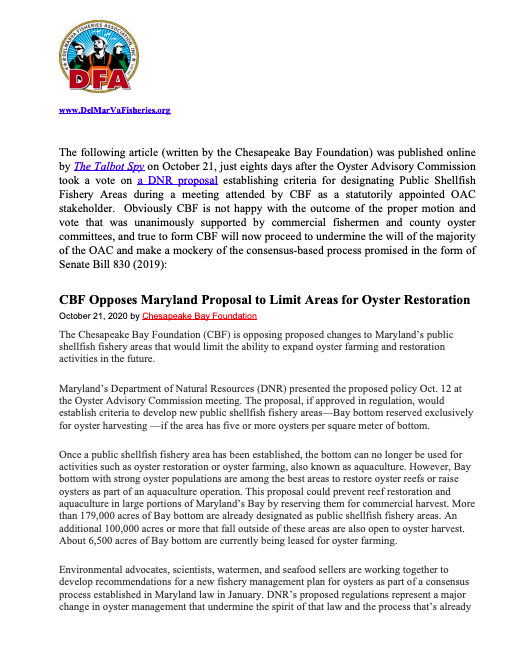CBF Opposes Maryland Proposal to Limit Areas for Oyster Restoration

The following article (written by the Chesapeake Bay Foundation) was published online
by The Talbot Spy on October 21, just eights days after the Oyster Advisory Commission
took a vote on a DNR proposal establishing criteria for designating Public Shellfish
Fishery Areas during a meeting attended by CBF as a statutorily appointed OAC
stakeholder. Obviously CBF is not happy with the outcome of the proper motion and
vote that was unanimously supported by commercial fishermen and county oyster
committees, and true to form CBF will now proceed to undermine the will of the majority
of the OAC and make a mockery of the consensus-based process promised in the form of
Senate Bill 830 (2019):
CBF Opposes Maryland Proposal to Limit Areas for Oyster Restoration
October 21, 2020 by Chesapeake Bay Foundation
The Chesapeake Bay Foundation (CBF) is opposing proposed changes to Maryland’s public
shellfish fishery areas that would limit the ability to expand oyster farming and restoration
activities in the future.
Maryland’s Department of Natural Resources (DNR) presented the proposed policy Oct. 12 at
the Oyster Advisory Commission meeting. The proposal, if approved in regulation, would
establish criteria to develop new public shellfish fishery areas—Bay bottom reserved exclusively
for oyster harvesting —if the area has five or more oysters per square meter of bottom.
Once a public shellfish fishery area has been established, the bottom can no longer be used for
activities such as oyster restoration or oyster farming, also known as aquaculture. However, Bay
bottom with strong oyster populations are among the best areas to restore oyster reefs or raise
oysters as part of an aquaculture operation. This proposal could prevent reef restoration and
aquaculture in large portions of Maryland’s Bay by reserving them for commercial harvest. More
than 179,000 acres of Bay bottom are already designated as public shellfish fishery areas. An
additional 100,000 acres or more that fall outside of these areas are also open to oyster harvest.
About 6,500 acres of Bay bottom are currently being leased for oyster farming.
Environmental advocates, scientists, watermen, and seafood sellers are working together to
develop recommendations for a new fishery management plan for oysters as part of a consensus
process established in Maryland law in January. DNR’s proposed regulations represent a major
change in oyster management that undermine the spirit of that law and the process that’s already
underway. This end-around the consensus-based process ties the hands of stakeholders working
to develop a shared vision for oyster management.
The proposal must still go through a public comment period and legislative review before it can
be established in regulation by DNR. CBF is urging DNR to consider tabling this proposal so
that it may be properly considered by the Oyster Advisory Commission members whose
legislative mandate is to cooperatively develop recommendations for oyster management that
increase oyster abundance and ends overfishing.
The reality is Maryland needs more oysters. Oysters filter and clarify water. Their reefs provide
habitat to blue crabs, fish, and other marine life. Despite these benefits, oyster populations in the
state remain at historic lows. Expanding areas for the exclusive use of harvesters that require no
replanting of oysters and excluding aquaculture operators, who are required to replant areas at
sustainable levels, seems highly unlikely to achieve this outcome.
CBF Maryland Fisheries Scientist Allison Colden issued the following statement about the
proposal:
“This proposal undermines the process put in place by the legislature to implement actions to
increase the oyster population and end overfishing. It appears to be a one-sided proposal to
increase the oyster harvest at the expense of restoration and aquaculture efforts that are helping
to bring Maryland’s oysters back. Making more of Maryland’s Bay bottom off-limits to
restoration and aquaculture makes no sense as oyster populations are wallowing at historic lows.
The state must balance the interests of the fishery with the environmental and social benefits
more oysters could provide, instead of reserving the remaining oysters in Maryland waters for
harvest.”